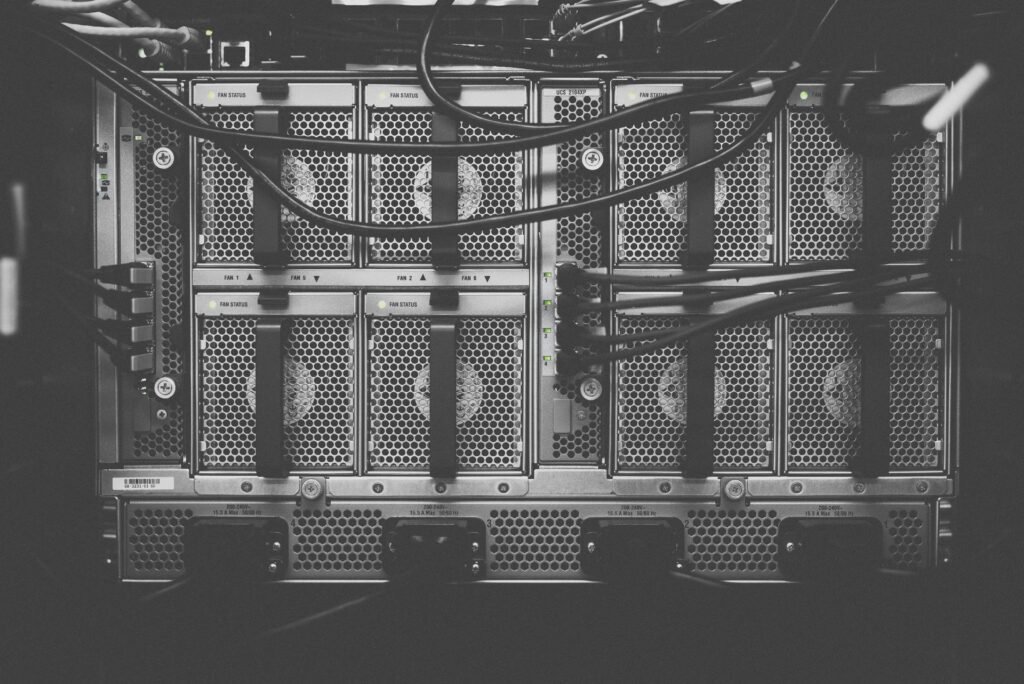Are you looking to take your business operations to the next level? Look no further than state-of-the-art machines. With their cutting-edge technology and advanced capabilities, these machines are revolutionizing industries across the globe. Whether you’re in manufacturing, healthcare, or any other field, incorporating state-of-the-art equipment into your operations can streamline processes, improve efficiency, and boost productivity. In this article, we will explore the benefits of optimizing operations with these advanced machines and how they can help your business stay ahead in today’s competitive market.

This image is property of images.unsplash.com.
Benefits of State-of-the-Art Machines
Improved Efficiency
State-of-the-art machines offer numerous benefits to businesses. One of the primary advantages is improved efficiency. These machines are designed with advanced technology and automation features that streamline processes and minimize manual intervention. By reducing the time required to complete tasks, state-of-the-art machines enable businesses to optimize their operations and increase productivity.
Increased Productivity
With state-of-the-art machines, businesses can significantly enhance their productivity levels. These machines are equipped with cutting-edge technology and automation capabilities that enable faster and more accurate production processes. By automating repetitive tasks and minimizing errors, businesses can achieve higher output rates and meet customer demands more efficiently.
Higher Quality Output
State-of-the-art machines are known for their ability to deliver high-quality output consistently. These machines are designed with precision engineering and incorporate advanced sensors and algorithms to ensure accuracy and reliability in production processes. By minimizing human error and optimizing control mechanisms, businesses can achieve superior quality output that meets or exceeds customer expectations.
Key Features of State-of-the-Art Machines
Advanced Technology
State-of-the-art machines incorporate the latest advancements in technology to enhance performance and functionality. These machines often leverage cutting-edge technologies such as artificial intelligence, machine learning, and Internet of Things (IoT) integration. By harnessing the power of advanced technology, businesses can improve their operations, achieve better results, and stay ahead of the competition.
Automation and Robotics
Automation and robotics are key features of state-of-the-art machines. These machines are designed to automate repetitive and time-consuming tasks, freeing up human resources for more strategic activities. By utilizing automation and robotics, businesses can increase efficiency, reduce operational costs, and minimize errors caused by manual intervention.
Real-Time Data Analysis
State-of-the-art machines are equipped with real-time data analysis capabilities that enable businesses to make informed decisions. These machines collect and analyze data during production processes, providing valuable insights into performance, efficiency, and quality metrics. By leveraging real-time data, businesses can identify opportunities for improvement, optimize processes, and ensure continuous enhancement in their operations.

This image is property of images.unsplash.com.
Optimizing Production with State-of-the-Art Machines
Streamlined Processes
State-of-the-art machines play a crucial role in streamlining production processes. By automating manual tasks and incorporating advanced technology, these machines enable businesses to achieve more efficient operations. They eliminate bottlenecks, minimize idle time, and optimize workflow, resulting in faster production cycles and improved overall productivity.
Reduced Downtime
State-of-the-art machines are designed for reliability and durability, reducing the chances of unexpected downtime. These machines undergo regular maintenance and are equipped with advanced diagnostics that enable proactive identification of potential issues. By minimizing downtime, businesses can maximize production uptime, meet customer demands effectively, and avoid costly delays.
Optimum Resource Utilization
State-of-the-art machines optimize resource utilization by minimizing waste and maximizing efficiency. These machines are designed with precise control mechanisms that ensure optimal usage of raw materials, energy, and other resources. By optimizing resource utilization, businesses can reduce costs, increase profitability, and contribute to sustainable practices.
Cost Savings and ROI with State-of-the-Art Machines
Energy Efficiency
State-of-the-art machines often come with energy-efficient features that reduce energy consumption. These machines are designed to optimize power usage, minimize idle time, and incorporate energy-saving technologies. By reducing energy consumption, businesses can lower their utility bills and contribute to environmental sustainability efforts while also achieving cost savings.
Labour Reduction
State-of-the-art machines automate repetitive tasks and minimize the need for manual labor. By eliminating manual intervention, businesses can reduce their labor costs and allocate human resources to more value-added activities. With state-of-the-art machines, businesses can achieve higher productivity levels with a smaller workforce, resulting in significant cost savings.
Long-Term Financial Benefits
Investing in state-of-the-art machines offers long-term financial benefits. While the initial capital investment may be higher, the returns on investment (ROI) can be substantial. With increased productivity, improved efficiency, and optimized resource utilization, businesses can generate higher revenues and reduce operational costs over time. The long-term financial benefits make it a wise decision for businesses to invest in state-of-the-art machines.

This image is property of images.unsplash.com.
Training and Adaptation for State-of-the-Art Machines
Employee Training Programs
Implementing state-of-the-art machines requires proper training for employees. Businesses should provide specific training programs to ensure that employees understand the operation and maintenance of these machines. By investing in comprehensive training programs, businesses can equip their employees with the necessary skills and knowledge to operate the machines effectively and maximize their potential benefits.
Change Management Strategies
Introducing state-of-the-art machines can bring about significant changes in working processes and organizational dynamics. It is essential for businesses to have robust change management strategies in place to ensure a smooth transition and minimize resistance to change. By effectively managing the implementation of these machines, businesses can facilitate adoption, optimize utilization, and maximize the benefits they offer.
Maintenance and Support for State-of-the-Art Machines
Regular Maintenance Schedules
To ensure optimal performance and longevity, state-of-the-art machines require regular maintenance. Businesses should adhere to maintenance schedules provided by manufacturers and conduct routine inspections, cleaning, and servicing as required. By following regular maintenance schedules, businesses can prevent unscheduled downtime, address potential issues proactively, and extend the lifespan of their machines.
Proactive Problem-Solving
State-of-the-art machines often come with advanced diagnostics and monitoring capabilities. By proactively monitoring machine performance and analyzing data, businesses can identify potential issues before they escalate into major problems. Proactive problem-solving allows businesses to minimize downtime, improve the reliability of their operations, and maintain productivity levels.
Technical Support from Manufacturers
State-of-the-art machines are usually backed by manufacturers who provide technical support and assistance. Businesses should establish a good working relationship with manufacturers and leverage their expertise whenever needed. By accessing technical support, businesses can address any technical issues promptly, receive guidance on optimization, and ensure their machines operate at peak performance.
Case Studies: Successful Implementation of State-of-the-Art Machines
Industry Examples 1
One example of successful implementation of state-of-the-art machines is in the automotive industry. Automakers have embraced advanced robotics, automation, and real-time data analysis to optimize their production processes. By integrating state-of-the-art machines into their assembly lines, automakers have achieved higher productivity, improved quality output, and reduced costs.
Industry Examples 2
The food and beverage industry has also witnessed successful implementation of state-of-the-art machines. High-tech packaging machines, automated food processing systems, and real-time quality control systems have revolutionized the industry. These machines have streamlined operations, increased production throughput, and ensured consistent product quality, leading to enhanced customer satisfaction and higher profitability.
Industry Examples 3
The healthcare industry has benefited greatly from state-of-the-art machines. Advanced medical imaging systems, robotic-assisted surgeries, and automated medication dispensing systems have improved patient care, increased accuracy, and reduced human error. Through successful implementation of these machines, healthcare providers have enhanced efficiency, enabled better diagnoses, and saved lives.
Considerations for Investing in State-of-the-Art Machines
Budget and Financial Planning
Investing in state-of-the-art machines requires careful budgeting and financial planning. Businesses should evaluate the costs involved, including the initial capital investment, training programs, maintenance, and ongoing operational expenses. By conducting a thorough financial analysis, businesses can ensure that they have the necessary funds and resources to invest in and sustain the operation of these machines.
Compatibility with Existing Systems
Before investing in state-of-the-art machines, businesses should consider the compatibility of these machines with their existing systems and infrastructure. It is essential to assess whether the machines can integrate seamlessly with the current setup or if any modifications or upgrades are required. Ensuring compatibility minimizes disruptions and maximizes efficiency during the implementation stage.
Long-Term Scalability
Scalability is a critical factor to consider when investing in state-of-the-art machines. Businesses should evaluate whether the machines can accommodate future growth and expansion plans. It is important to select machines that can be easily upgraded or expanded to meet changing business needs. By considering long-term scalability, businesses can make investments that provide value and flexibility for the future.
Future Trends in State-of-the-Art Machines
Industry 4.0 and IoT Integration
The future of state-of-the-art machines lies in Industry 4.0 and IoT integration. Machines will become more interconnected, enabling seamless communication and collaboration between different production processes and systems. With IoT integration, real-time data analysis, and predictive maintenance capabilities, businesses can further optimize their operations, gain valuable insights, and stay competitive in the digital era.
Artificial Intelligence and Machine Learning
Artificial intelligence (AI) and machine learning (ML) will play a significant role in the future of state-of-the-art machines. These technologies will enable machines to learn, adapt, and make intelligent decisions based on data analysis and pattern recognition. AI and ML capabilities will enhance automation, optimize processes, and unlock new levels of efficiency and productivity.
Human-Machine Collaboration
The future of state-of-the-art machines is not about replacing humans but rather collaborating with them. Machines will complement human skills and capabilities, working alongside employees to enhance productivity and creativity. With human-machine collaboration, businesses can leverage the strengths of both humans and machines, resulting in improved outcomes, innovation, and job satisfaction.
Challenges and Risks of Implementing State-of-the-Art Machines
Initial Capital Investment
One of the challenges of implementing state-of-the-art machines is the initial capital investment required. These machines often come with a higher price tag due to their advanced technology and features. Businesses need to carefully evaluate the costs and benefits to ensure a positive return on investment in the long run.
Technological Obsolescence
As technology evolves rapidly, there is a risk of investing in state-of-the-art machines that may become obsolete in a short period. Businesses need to stay updated with the latest advancements and trends to ensure that their machines remain relevant and competitive. Regular assessments and upgrades may be necessary to avoid technological obsolescence.
Cybersecurity Risks
State-of-the-art machines are connected to networks and potentially vulnerable to cybersecurity threats. Businesses need to implement robust cybersecurity measures to protect their machines and data from unauthorized access, data breaches, and malware attacks. Adequate security measures, including strong firewalls and encryption technologies, should be in place to mitigate cybersecurity risks.
In conclusion, state-of-the-art machines offer numerous benefits to businesses, including improved efficiency, increased productivity, and higher quality output. With advanced technology, automation capabilities, and real-time data analysis, these machines optimize production processes and achieve cost savings and long-term financial benefits. However, businesses must invest in employee training, change management strategies, and maintenance support to maximize the potential benefits. Future trends in state-of-the-art machines include IoT integration, AI and ML advancements, and human-machine collaboration. Despite the challenges and risks, businesses can overcome them through careful consideration of budgets, compatibility, and long-term scalability. By embracing state-of-the-art machines, businesses can optimize their operations, stay competitive, and pave the way for innovation and success in the digital age.
